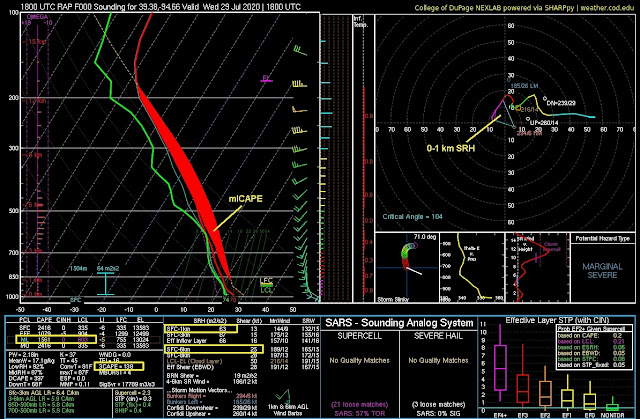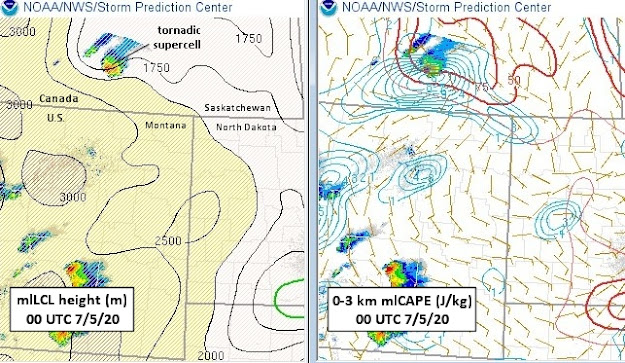This blog post is about Bob Johns, long-time Storm Prediction Center severe weather forecaster/researcher, who passed away at age 78 this past week after a long illness.
He was such an incredible influence in my life.
In the late 1980's, I had worked in television and consulting firms for several years without finding much stability or direction in my weather career. I had moved back to my home area to help take care of my ailing mom and assist my dad with his expanding home medical business in rural Kansas. I thought my career in weather was over.
However, I still had an interest in severe weather.
In 1989, I drove to Kansas City and the National Severe Storms Forecast Center (NSSFC, now the Storm Prediction Center) to find meteorological maps for some 1988 tornado events (there was no internet with online weather information yet). As I was shuffling through paper in their map archive room, Bob Johns walked by and introduced himself. We started talking, and that conversation changed the course of my life.
Bob sensed the untapped passion I had for tornado forecasting and severe weather research, something that hadn't been encouraged by anyone I had worked with so far. To my surprise, he enlisted me in a research project he wanted to do using weather balloon soundings archived from the 1980's to examine environments of significant tornadoes using newer measures of wind shear. Something like that wasn't easy to do back then without the sophisticated computer software for analyzing soundings that we have now.
The result was several research papers we authored together in the early 1990's that laid some groundwork for using wind shear and instability combinations in tornado forecasting. This included the Energy-Helicity Index (along with SPC forecaster and programming wiz John Hart) as a composite parameter in tornado forecasting.
I was thrilled that he asked me to work with him on this project. In his quiet but enthusiastic way, one of Bob's gifts was recognizing people's abilities and inspiring them to use and develop them. I am very blessed that he took an interest in me, and his mentorship was essential in nudging me in a different direction at a key time in my life.
Here'a photo of NSSFC staff back in 1977: along with Bob Johns, it includes forecasters Steve Weiss, Larry Wilson, and Jack Hales. Bob introduced me to these NSSFC 'stalwarts', who were all very kind and encouraging to me. I also met severe weather icons Chuck Doswell, Don Burgess, Robert Davies-Jones, and others through him, which was quite amazing yet humbling for someone so new to weather research and writing.
Bob started at NSSFC in Kansas City in 1971, learned much about severe weather forecasting and issuing watches from forecaster Larry Wilson, and became a lead forecaster at NSSFC by 1979. He worked in that capacity until 1994 when he became Scientific Operations Officer at the time SPC moved to Norman, Oklahoma. He retired in 2001, after which he worked part-time. It is noteworthy that Bob introduced the enhanced "Particularly Dangerous Situation" (PDS) wording to tornado watches during the 2 April 1982 tornado outbreak in Texas, Arkansas, and Oklahoma.
Chicago weather legend Tom Skilling wrote the following on Facebook after Bob John's passing this week:
"Anyone who has worked in the meteorological profession has read and studied Johns' remarkable work on severe weather--work produced over an amazing decades-long career...
I first met Bob at one of our Fermilab Tornado and Severe Weather seminars back in the 1990s... For someone who had so profoundly impacted the meteorological profession over his decades long career, it was such a joy to discover a soft-spoken man with a warm smile. Bob was so kind and so easy to approach... He had a passion toward meteorology and, in particular, severe weather and the manner in which nature put it together. He spent his professional life cataloging what he had learned and worked tirelessly passing this information on to his colleagues and all interested in the subject."
I couldn't describe Bob better myself. As Tom also mentioned in his FB post:
"His work on the prediction of "derechoes", the fast moving and destructive squall lines like the one which raced across our area at highway speed this past August, has been described as the "bible" on the subject for forecasters. His forecast techniques are still in use today. Johns published his study on the phenomenon with his National Weather Service colleague Bill Hirt in 1987."
Here's that paper: Johns, R. H., and W. D. Hirt, 1987: Derechos: widespread convectively induced windstorms. Wea. Forecasting, 2, 32-49.
Bob's work on derechos (see my blog post on last August's derecho) helped make meteorologists and the public more aware of these large, destructive, and potentially deadly windstorms that can blast across several states. His research has saved lives as a result.
Here's references for a little more of Bob's work:
- Johns, R. H, and C. A. Doswell III, 1992: Severe local storms forecasting. Wea. Forecasting, 7, 588-612.
- Johns, R. H., 1993: Meteorological conditions associated with bow echo development in convective storms. Wea. Forecasting, 8, 294-299.
- Johns, R. H., J. M. Davies, and P. W. Leftwich, 1993: Some wind and instability parameters associated with strong and violent tornadoes, 2. Variations in the combinations of wind and instability parameters. The Tornado: Its Structure, Dynamics, Prediction, and Hazards, Geophys. Monogr., No. 79, C. Church, D. Burgess, C. Doswell III, and R. Davies-Jones, Eds., Amer. Geophys. Union, Washington, DC, 583-590.
- Johns, R. H., and R. A. Dorr, Jr., 1996: Some meteorological aspects of strong and violent tornado episodes in New England and eastern New York. Natl. Wea. Dig., 20:4, 2-12
- Johns, R. H., D. W.Burgess, C. A.Doswell III, M. S.Gilmore, J. A.Hart, and S. F.Piltz, 2013: The 1925 Tri-State tornado damage path and associated storm system. Electronic J. Severe Storms Meteor., 8, http://ejssm.org/ojs/index.php/ejssm/article/viewArticle/109.
As the last paper above reflects, Bob spent years studying and reconstructing the damage path of the famous 1925 Tri-State tornado in Missouri, Illnois, and Indiana. It was a serious and fascinating subject for him. That classic 2013 paper Bob wrote with Chuck Doswell, Don Burgess, and John Hart serves as the authoritative documentation and reference for that remarkable tornado.
A more comprehensive list of Bob's published papers can be downloaded here: http://www.ejssm.org/ojs/index.php/ejssm/article/downloadSuppFile/29/79
And for those who'd like more background on Bob John's growing up in Indiana and the development of his passion for severe weather, here's John M. Lewis' article about him in 2007: https://ejssm.org/ojs/index.php/ejssm/article/view/29/32
Back in 2001, I was honored to be part of an evening seminar and review of the 1991 Andover, Kansas tornado where Bob talked about his handling of the event as a forecaster at NSSFC/SPC:
He taught me so much about research, staying disciplined, being practical, and staying clear in my focus and writing. Bob helped give me confidence that I was missing in my young life, and he also taught me about being a decent human being, I owe him a great deal.
A final thought... Bob Johns was a wonderful reminder that we should treat those newer people finding their way in our chosen profession with respect and a helpful spirit. He exemplified the importance of 'paying it forward' when we've had the good fortune to do what we love.
Rest in Peace, my friend. You will not be forgotten.
- Jon Davies 11/30/20
























































